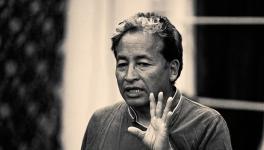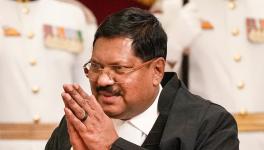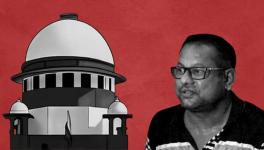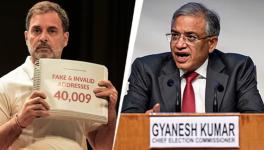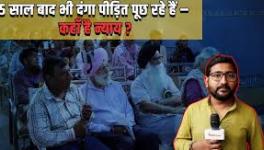Strong Executive, Weak Courts
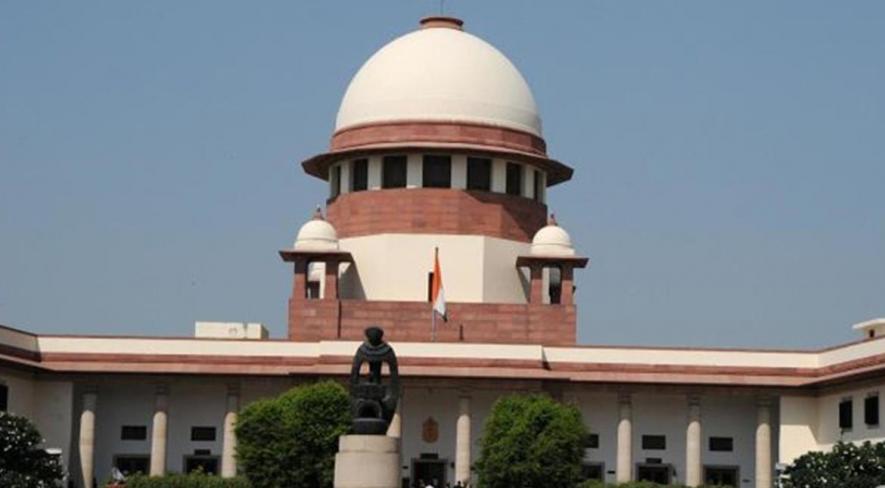
Image Used for Representational Purpose Only
In recent times, the downgrading of India’s constitutional democracy credentials has been subject to severe domestic and global critiques. Nevertheless, Indian diplomatic positions at global fora continue to emphasise its track record as a vital democracy with sound judicial safeguards to protect human rights. This contradiction, when analysed from a historical perspective, reveals notable warning signs for the sustenance of India’s constitutional democracy. The Emergency (1975-76) was a dark phase of India’s history, cautioning us to not follow certain paths in the future if India wants to uphold the true principles of constitutional democracy.
However, the present seems to be ignoring the guidance of the past and there is a virtual reappearance of the Emergency-era executive dominance of judiciary, factually merging all power within one entity, the ruling political party. Rupturing judiciary is one of the main facets of the larger democratic decay happening at multiple levels: (1) crushing parliamentary deliberations (see here, here and here); (2) faltering institutional independence (see here and here); and (3) shrinking space for public expression and dissent (see here and here).
This phenomenon is not specific to India, but universal. Tarunabh Khaitan has correctly identified the “elected political executives as the chief threat to democracy today.” This article is an endeavour to revisit the past, compare it with the present and make the holder of Indian sovereignty aware of the collapsing separation of powers.
Article 124 of the Constitution governs the process of appointment of Supreme Court judges. It vests this power with the President, to be exercised after consultation with the judiciary. In initial years of the Republic, the executive rejected multiple recommendations of the judiciary for prospective appointees of the courts. This led the Law Commission of India, functioning under the chairmanship of late MC Setalvad, to opine that “the Constitution endeavoured to put judges of the Supreme Court above executive control”.
A new era of Indian democracy began with the appointment of Indira Gandhi as prime minister. In the background of multiple Supreme Court rulings against the executive (see here and here) and with the sense of authoritative rule, full blown court-packing attempts were made during the 1970s. Constitutional scholar Granville Austin has said that “this was a grievous blow to democratic constitutionalism, for, by attempting to make the court obedient to her governance, she was unbalancing the power equation among the three branches of the government and distorting the seamless web.”
Finally, the reality of excessive executive influence, compromised judicial independence and, most importantly, the retirement of judges appointed in the 1970s, dawned. The Supreme Court asked the decision in the Gupta case be reconsidered in Subhash Sharma v Union of India (1990). While doing so, in Supreme Court Advocate-on-Record Association v. Union of India (1993), the Court innovated the collegium system of appointment. Herein, a group of the judges gets the primacy in the appointment process. It was later reconfirmed by the Supreme Court in In re Special Reference No. 1 of 1998 (1998), with minor changes.
THE CONTEMPORARY CONTROVERSIES
Multiple controversies in the realm of judicial appointments and transfers have surfaced in the past four-five years, raising concerns about faltering institutional autonomy of the members of higher judiciary. These could be classified under two groups: one, which questioned the opaque and arbitrary nature in which the collegium is functioning [See here, here, here, here and here]; and two, which raised questions about independence of the judiciary in light of executive influence. We restrict our study to controversies under the second category.
India got its 16th Lok Sabha in May 2014 under the leadership of Prime Minister Narendra Modi. Meanwhile, the Supreme Court had recommended the name of the eminent senior advocate Gopal Subramanium for elevation to the Supreme Court. However, in June 2014, the government returned his file for reconsideration. Feeling ‘let down’, Subramanium withdrew his candidature alleging that the government is trying to find dirt on him to declare his candidature as unsuitable. Outlook has noted, “Subramanium, who had assisted the Supreme Court in the Sohrabuddin fake encounter case in which Amit Shah, a close aide of Prime Minister Narender Modi is now an accused, said that he was being ‘targeted’ because of his independence and integrity.” Interestingly, Shah is now Home Minister in the central government. This initiated a serious of executive interference in judicial appointments and transfers.
Next came the transfers of Justice Rajiv Shakdhar from the Delhi High Court to the Madras High Court and Justice Abhay Mahadeo Thipsay from the Bombay High Court to the Allahabad High Court (a year before he was to retire). Justice Shakdhar’s involuntary transfer in 2016 was notable, because it came after he struck down restrictions on the rights group Greenpeace, raising eyebrows. Both these transfers were perhaps due to executive pressure and without the consent of the judges, which is considered against Supreme Court precedents and termed as the ‘When you like’ approach by the reknown jurist Rajeev Dhavan.
Then, in 2017, Justice Jayant Patel, slated to be appointed as the Chief Justice of the Karnataka High Court, resigned upon being transferred to the Allahabad High Court. This would have reduced his chances of being elevated to the Supreme Court, owing to his seniority being downgraded had he moved to the Allahabad High Court. He was a member of the Bench of the Gujarat High Court that had ordered a CBI probe in the Ishrat Jahan encounter case, again involving Shah and Modi.
In September 2019, there are two additions to this list. The first is the “involuntary” transfer of the Chief Justice of Madras High Court, Justice Tahilramani, to one of the smallest and youngest High Courts in the country. Such a transfer of a Chief Justice from a chartered High Court is an obvious downgrade and amounts to humiliation. It is widely speculated that her judgement convicting the culprits in the Bilkis Bano case of the 2002 Gujarat riots is the main reason for the transfer. Justice Tahilramani resigned from the judiciary after the collegium rejected her representation.
The other controversy involves Justice Akil Kureshi. Earlier this year, the collegium recommended appointing him as Chief Justice of Madhya Pradesh High Court. The Government returned this proposal without approving it. On 5 September, the collegium, while allegedly “surrendering” before the executive, decided to transfer him to the Tripura High Court. One probable reason cited for this in media reports is that he had previously ordered a two-day police remand for Shah in the Sohrabuddin case.
A politically-charged interference makes a mockery of judicial independence. The Bombay Bar Association has also shown its disapproval: “modification [in the transfer order]… at the behest of the government undermines the independence of the judiciary.”
This series of events has provoked the debate about balancing judicial independence with accountability in the context of an ever-powerful political executive that is increasingly averse to respecting judicial autonomy. Certainly, the resignations and involuntary transfers of senior judges marks the onset of a crisis phase. For, the resignation does not highlight an individual grievance. It also underlines the fact that those entrusted with upholding the independence of the judiciary have allowed themselves to be used by the executive as pawns in pursuit of a vindictive agenda.
The Supreme Court very recently said that appointments and transfers are pivotal to the administration of justice in which the executive must not interfere, but executive dominance over these matters indicates the opposite. The secretary general of the Supreme Court has justified the decisions, stating they were taken for cogent reasons. However, Justice DY Chandrachud, a sitting judge of the Supreme Court, has recently noted that transfers are not an effective remedy when accountability is sought from the judiciary. (He also highlighted concerns regarding deficient transparency in functioning of the collegium system.)
In 1977, Justice VR Krishna Iyer warned in the Sankal Chand Sheth case that “public power is a lofty trust to be operated and, if private impulses or public aberrations play upon the exercise, the Court shall quash the lawless fiat.” The collegium is not a creation of the Constitution, but the court itself. Yet, when its decisions are questioned for influence, there is no institutional check or transparency. Arghya Sengupta has also argued that in the age of accountability, the collegium must reveal reasons for its decision to the public because it affects the public interest.
In Supreme Court Advocates-on-Record Association v. Union of India (2015), while dealing with the constitutionality of the National Judicial Appointments Commission, the Supreme Court highlighted the virtues of judicial independence at considerable length; and noted the fact that it is a part of the basic structure of the Constitution.
Concerns of isolating the judicial body from the other organs of the government have been institutionally studied by the International Commission of Jurists and under multiple international documents.
A demonstration of its independent strength is not only lacking in the realm of judicial appointments, but extends to all those political matters which involve high stakes. On the manner in which the Supreme Court handled petitions arising out of Artcle 370, legal commentator Gautam Bhatia argues that the weak judiciary of the Emergency-era has reappeared, though in different form, and it has failed the fundamental principles of India’s constitutional democracy.
The only hope now is that the Supreme Court realises its true independence and follows the ideal of Justice HR Khanna, because but for structurally-separated powers, the rule of law transforms into rule by law (rarely into rule by man), collapsing the two fundamental ideals that sustain a constitutional democracy. It is time the judiciary stepped up to fulfil its role and ensure that the Constitution is not reduced to just another legal document.
In the times when the Executive’s imposition of an information blackout and civil rights restrictions in Kashmir have continued for over 60 days and blatantly unconstitutional legislations like the Citizenship (Amendment) Bill are sought to be passed, the judiciary must rise to the desired standards and stand as an independent protector of the Constitution. And in that context, it must safeguard its institutional autonomy in the domain of appointments and transfers from undesirable executive interference.
Prannv Dhawan and Anmol Jain are law students in NLU Jodhpur and Bangalore, respectively. Views are personal.
This article was published in The Leaflet and has been reproduced with permission.
Get the latest reports & analysis with people's perspective on Protests, movements & deep analytical videos, discussions of the current affairs in your Telegram app. Subscribe to NewsClick's Telegram channel & get Real-Time updates on stories, as they get published on our website.










